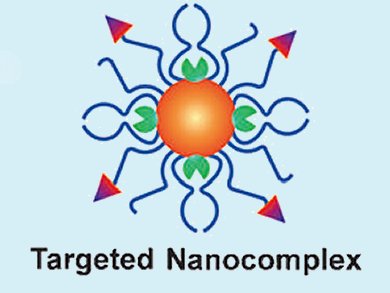A New Approach to Gene Therapy
Resistance of tumor cells toward multiple cytostatic drugs is a serious problem in cancer treatment. In the journal Angewandte Chemie, a team of Chinese and American researchers has now introduced a new approach to gene therapy that could counter this problem: The gene that codes for resistance is “silenced” through the use of an ingenious nanocomplex.
Every cell in our body contains our complete genetic information. However, not all genes are used in every cell at all times. Regulatory processes are needed to determine when a gene should be read and transcribed to messenger-RNA (mRNA), and the corresponding protein built. One such mechanism is RNA silencing. In this mechanism, short, specific, silencing RNA (siRNA) fragments bind to the mRNA to be silenced with participation from several enzyme complexes. The enzymes cleave the mRNA, preventing its translation into a protein. Gene therapies based on synthetic siRNA are under clinical development.
However, these siRNA drugs are directed toward the cellular silencing “machinery” and may disrupt natural gene regulation pathways, which results in side effects. In addition, they require a transport system to carry them through the cell membrane and to protect them from rapid degradation. Led by Min Yang at the Jiangsu Institute of Nuclear Medicine, Wuxi, China, and Xiaoyuan Chen at the National Institutes of Health, Bethesda, USA, the researchers have now developed an alternative approach that doesn’t have these disadvantages. It is based on a nanocomplex that already includes the required machinery and packaging.
RNA-Silencing Nanocomplexes
The researchers chose to use gold nanoparticles as their support and transport system. They attached three components to the nanoparticles’ surfaces: 1) RNAse A, a robust enzyme that nonspecifically cleaves single-stranded RNA; 2) DNA oligonucleotides with a sequence selected to specifically bind the mRNA to be taken out of circulation; 3) A ligand that is designed to pilot the nanocomplex to the target cells – tumor cells in this case. The scientists chose Cys-tag EGF, a ligand that binds to a growth-hormone receptor present in significantly elevated quantities in the cell membranes of many tumors.
One important mechanism of multidrug resistance in tumor cells is the active expulsion of drugs by means of a special transport protein (Pgp). Administration of chemotherapy drugs triggers formation of a large number of these transporters, which effectively protect the tumor cells from the drugs.
In order to silence the gene that codes Pgp, the researchers incorporated DNA that recognizes the corresponding mRNA into the nanocomplexes. They were thus able to observe cleavage of this mRNA, a reduction in the concentration of Pgp, and renewed sensitivity toward the chemotherapy drug doxorubicin in multidrug-resistant tumor cell lines. In addition to combating multidrug resistance, the new method should prove to be a generally useful approach for gene therapy.
- Biomimetic RNA-Silencing Nanocomplexes: Overcoming Multidrug Resistance in Cancer Cells,
Zhongliang Wang, Zhe Wang, Dingbin Liu, Xuefeng Yan, Fu Wang, Gang Niu, Min Yang, Xiaoyuan Chen,
Angew. Chem. Int. Ed. 2014.
DOI: 10.1002/anie.201309985




